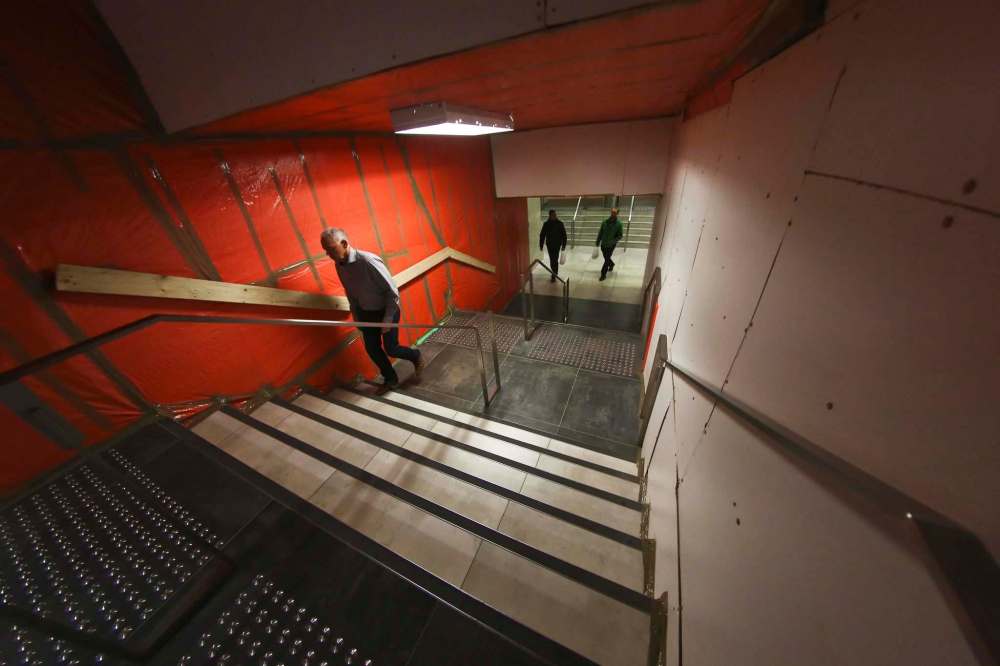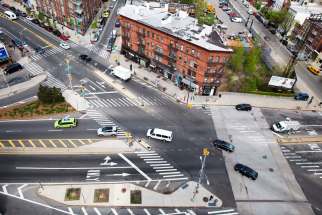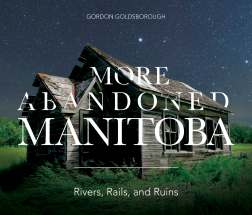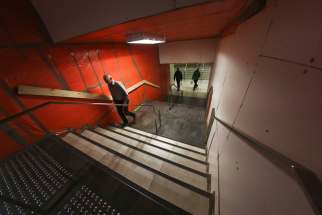Buried, broken heart Removing barriers won't transform intersection; it opens the door for something that will
Read this article for free:
or
Already have an account? Log in here »
To continue reading, please subscribe:
Monthly Digital Subscription
$0 for the first 4 weeks*
- Enjoy unlimited reading on winnipegfreepress.com
- Read the E-Edition, our digital replica newspaper
- Access News Break, our award-winning app
- Play interactive puzzles
*No charge for 4 weeks then price increases to the regular rate of $19.00 plus GST every four weeks. Offer available to new and qualified returning subscribers only. Cancel any time.
Monthly Digital Subscription
$4.75/week*
- Enjoy unlimited reading on winnipegfreepress.com
- Read the E-Edition, our digital replica newspaper
- Access News Break, our award-winning app
- Play interactive puzzles
*Billed as $19 plus GST every four weeks. Cancel any time.
To continue reading, please subscribe:
Add Free Press access to your Brandon Sun subscription for only an additional
$1 for the first 4 weeks*
*Your next subscription payment will increase by $1.00 and you will be charged $16.99 plus GST for four weeks. After four weeks, your payment will increase to $23.99 plus GST every four weeks.
Read unlimited articles for free today:
or
Already have an account? Log in here »
Hey there, time traveller!
This article was published 19/10/2018 (2613 days ago), so information in it may no longer be current.
In the heart of the city, there is nothing but lonely. A wind-battered corner, calcified at the edges, growling with late-afternoon engines. The only other sound is flags, rattling impotently at their poles, but no one is around to hear them.
There is nothing for you here. You want to walk away. But to cross the heart of the city, you must first go under.
There is no way around it; you have go do down, descending into the yellow-lit subterranean deep. Past the pile of damp leaves in the stairwell. Past an illustrated map in a rusted frame and a railing long since stripped of its paint.
You pause in front of a sign bearing a diagram of Portage and Main. There’s a black hole drawn underneath.
“You are here,” the sign says, but of course, you’re not really anywhere.
To be somewhere, you would have to be in a place where a city truly interfaces with its people. Where you could suggest a date meet you. Where you could watch the world pass and not need a sign to explain where you are.“But you are not anywhere. You are a body in transit, circling a ruddy-bricked drain. It does not encourage you to linger. Left or right, pick a direction. Step and echo. Step and echo. Cast your eyes to the side. Or just look down.”
But you are not anywhere. You are a body in transit, circling a ruddy-bricked drain. It does not encourage you to linger. Left or right, pick a direction. Step and echo. Step and echo. Cast your eyes to the side. Or just look down.
When I was young, I worked as an intern at an office on nearby Lombard Avenue. For lunch, I wandered through downtown’s guts. Once, I realized I had circled the circus three times, losing my exit, hypnotized by its sameness.
We took our most famous intersection and made it into a purgatorio of liminal space.
If only there was another way to make this transition. There used to be — in living memory, even — and could have been, had different decisions been made in the late 1970s. There still could be again, should we choose to claim it.
Oh, I have no illusions about the likelihood of success. Still, with election day nearing, I have to claim it.
This is my first confession: I am exhausted by Portage and Main. I am beyond tired of thinking about it, tired of hearing about it, tired of the brittle debate it enjoins. I am tired of seeing Winnipeggers dug into civic trenches.
And I am tired of how obvious it is, how predictable, how much of this drama could have been scripted from the beginning. There is nothing more quintessentially Winnipeg than a bruising public debate over crossing a street.
There are so few meaningful angles to debate and so few decent solutions. The intersection is absolutely poorly accessible for people with disabilities. We know the barricades have to come down for significant repairs anyway.
If the aging barricades are rebuilt, we’re still out the money. If the intersection stays closed, improvements to accessibility will still need to be found. This is not a particularly layered issue about civic priorities or spending.
Maybe, if the barricades come down, it will take a little longer to drive through the intersection at peak hours. Depending on which estimate you believe, it could be a handful of seconds or, at worst, a couple of minutes.
Still, other projects slow down car commutes and receive only a whisper of this amount of public passion.

It’s because none of these, I think, are the real issue. What drives the debate on Portage and Main isn’t really commute times or spending. It is something else, something deeper, something more viscerally fundamental.
“You are here,” the sign says, but the design suggests you should be almost anywhere else.
This is my second confession: I ache to open Portage and Main, to claim it again as a pedestrian space. Some nights I lie awake, imagining what it could look like in the years to come, what could animate its broad corners.
Intersections are, by nature, places of movement and congregation. They draw people together; it’s good for momentum and good for business. We should know this because we live in a city raised at the intersection of rivers.
In Portland, Ore., a picturesque and vibrant downtown core is built of famously tiny city blocks. City planners designed them to be just 60 metres long, for one simple reason — it meant there would be more intersections.
More intersections, more spots for people to cross and more of the valuable corner lots businesses favour.
And the simplest pleasures of city life happen at intersections. In Tokyo, people-watching at the famous Shibuya scramble crossing. In Winnipeg, sitting on the bench at River and Osborne, sipping cool tea on a summery day.
Beneath the smothering concrete, Portage and Main whispers of that potential. It remains part of our civic consciousness, even as it remains inaccessible. Visitors know about it, though I’m never entirely sure how.“This is my second confession: I ache to open Portage and Main, to claim it again as a pedestrian space. Some nights I lie awake, imagining what it could look like in the years to come, what could animate its broad corners.”
And it is still, after all these decades, locked away, the jewel in our mental map of the city.
Consider: when the Winnipeg Jets were reborn, Portage and Main is where fans flooded to celebrate the news. Euphoria broke the dam that holds people back. They spilled over the barricades, cheering, inexorably drawn to meet there.
So when you vote Wednesday, this is what I beg you to consider. It’s not a long argument. It’s simple.
Opening Portage and Main will sprinkle no gold on Winnipeg’s downtown. It is not a panacea. It will not unravel decades of anemic urban policy, will not solve generational trauma and poverty, will not cure what ails the city.
But if the barricades come down — and if nothing else — we create potential. We reclaim the intersection’s natural birthright as a place of convergence. We generate options for what it can be: a place of welcome, of community.
In short, if we open the street, then we at least create the possibility for more possibilities.
Or we can keep the intersection closed. Nothing will change. There will be no potential, no room for new visions. There will be nothing more to do at our most famous intersection but begin the cycle of letting it rot all over again.
That is why I am voting to open. It is not because I think that opening it will be any salvation. It is because a place stripped of its potential is a place that stops growing. I love Winnipeg too much to leave its heart to the cold winds.
“You are here,” the sign says. All I want is the option to dream of where that can be.
melissa.martin@freepress.mb.ca
Our newsroom depends on a growing audience of readers to power our journalism. If you are not a paid reader, please consider becoming a subscriber.
Our newsroom depends on its audience of readers to power our journalism. Thank you for your support.









